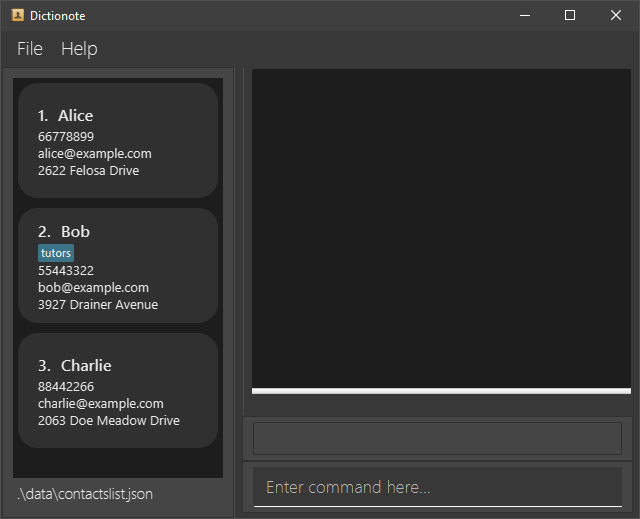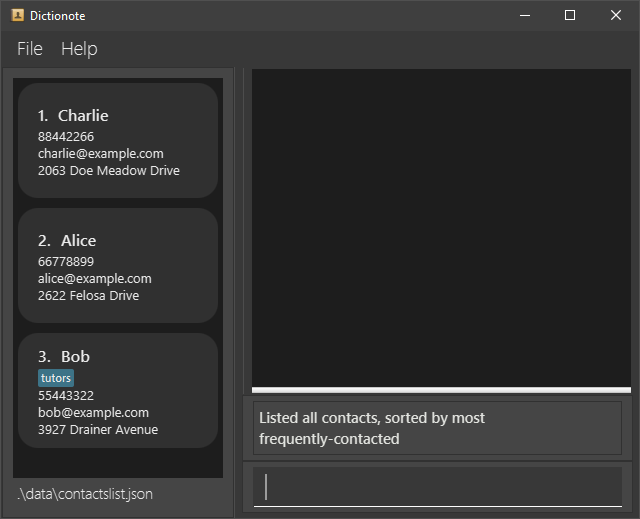Developer Guide
- Introduction
- Setting up, getting started
- Design
- Implementation
- Documentation, logging, testing, configuration, dev-ops
- Appendix: Requirements
- Appendix: Instructions for manual testing
Introduction
Purpose
The purpose of this document is to cover the multi-level design architecture of Dictionote, so that the intended audience of this document can understand the relationship between components that make up Dictionote.
Audience
This developer guide is for anyone who wants to understand the internal software architecture of Dictionote. The following groups of people are the intended audience:
- Dictionote developers: anyone who wish to upgrade Dictionote to support more functions.
- CS2103/T students: students of CS2103/T who want to improve their efficiency and productivity in learning.
Dictionote Overview
Dictionote is a desktop app for CS2103/T Students, optimized for use via a Command Line Interface (CLI) while still having the benefits of a Graphical User Interface (GUI). Dictionote in general helps to organise content and definitions from the CS2103/T textbook, provide Note-keeping functions to facilitate learning, and enhance the ability for students to connect and learn together with their cohort mates.
Setting up, getting started
Refer to the guide Setting up and getting started.
Design
Architecture

The Architecture Diagram given above explains the high-level design of the App. Given below is a quick overview of each component.
.puml files used to create diagrams in this document can be found in the
diagrams folder.
Refer to the PlantUML Tutorial at se-edu/guides
to learn how to create and edit diagrams.
Main has two classes called Main
and MainApp. It is responsible for,
- At app launch: Initializes the components in the correct sequence, and connects them up with each other.
- At shut down: Shuts down the components and invokes cleanup methods where necessary.
Commons represents a collection of classes used by multiple other components.
The rest of the App consists of four components.
-
UI: The UI of the App. -
Logic: The command executor. -
Model: Holds the data of the App in memory. -
Storage: Reads data from, and writes data to, the hard disk.
Each of the four components,
- defines its API in an
interfacewith the same name as the Component. - exposes its functionality using a concrete
{Component Name}Managerclass (which implements the corresponding APIinterfacementioned in the previous point.
For example, the Logic component (see the class diagram given below) defines its API in the Logic.java interface
and exposes its functionality using the LogicManager.java class which implements the Logic interface.

How the architecture components interact with each other
The Sequence Diagram below shows how the components interact with each other for the scenario where the user issues
the command delete 1.

The sections below give more details of each component.
UI component

API :
Ui.java
The UI consists of a MainWindow that is made up of parts e.g.CommandBox, ResultDisplay, NoteListPanel, NoteCard etc.
All these, including the MainWindow, inherit from the abstract UiPart class.
The UI component uses JavaFx UI framework. The layout of these UI parts are defined in matching .fxml files
that are in the src/main/resources/view folder. For example,
the layout of the MainWindow
is specified in MainWindow.fxml
The UI component,
- Executes user commands using the
Logiccomponent. - Listens for changes to
Modeldata so that the UI can be updated with the modified data. - Use
Logiccomponent to update the UI with new settings. -
DictionaryContentPaneluseDictionaryListPanelConfigto detectDictionaryListPaneldisplay status - Model Component can request for content change using
DictionaryContentConfigandNoteContentConfig
Logic component

API :
Logic.java
-
Logicuses theDictionoteBookParserclass to parse the user command. - This results in a
Commandobject which is executed by theLogicManager. - The command execution can affect the
Model(e.g. adding a person). - The result of the command execution is encapsulated as a
CommandResultobject which is passed back to theUi. - In addition, the
CommandResultobject can also instruct theUito perform certain actions, such as displaying help to the user.
Given below is the Sequence Diagram for interactions within the Logic component for the execute("delete 1") API call.

DeleteCommandParser should end at the destroy marker (X) but due to a limitation of PlantUML, the lifeline reaches the end of diagram.
Model component

API : Model.java
The Model,
- stores a
UserPrefobject that represents the user’s preferences. - stores the data for
Dictionote, includingContactsList,NoteBook,DictionaryBookandDefinitionBook. - exposes an unmodifiable
ObservableList<Contact>,ObservableList<Note>,ObservableList<Content>,ObservableList<Definition>that can be ‘observed’ e.g. the UI can be bound to this list so that the UI automatically updates when the data in the list changed. - does not depend on any of the other three components.
The ContactsList stores the Contact of the user. A Contact consists of Name, Email, Phone, Address, FrequencyCounter, and a custom Tag class.
The NoteBook stores the Notes of the user. A Note also has a Tag class. The Dictionary stores both the Definition and Content in the Dictionote.
Tag list in the ContactList and NoteBook, which Contact and Note references, respectively. This allows ContactList and NoteBook to only require one Tag object per unique Tag in each “Book”, instead of each Contact and Note needing their own Tag object, respectively.
Storage component

API : Storage.java
The Storage component,
- can save instances of the following classses in JSON format and read it back:
-
UserPref. -
ContactsList. -
NoteBook. -
Dictionary. -
DefinitionBook.
-
- depends on a few classes in the
Modelcomponent; however, such dependencies are not shown in the diagram for simplicity’s sake.
Common classes
Classes used by multiple components are in the seedu.dictionote.commons package.
Implementation
This section describes some noteworthy details on how certain features are implemented.
Contact features
Sending an email to a contact
Implementation
This feature is implemented as a command, EmailCommand, that extends Command. It is an index-dependent command, meaning that the user must provide an index number when typing the command as a reference to a specific contact on the contacts list. In addition, the command has an optional index number argument that refers to a note within the note book.
The index number was selected to refer to a particular contact. This is due to its character length being shorter in most cases than any other field of information in Contact objects, making it both simple and sufficient. Likewise, notes are referred to by their index numbers for the same reasons.
The execute() method attempts to open a new window of the user’s operating system (OS) default mail client. This is done by navigating to a mailto link with the contact’s email address added to the end. In case a note index number is provided, the contents of the note located at the specified index number will be copied to the messages’s body field.
If the command is executed successfully, the target contact’s frequency counter (see Sorting the contacts list by most-frequently contacted below) will be incremented by one.
As an example, consider running Dictionote on a Windows 10 machine with Microsoft Outlook as the OS default mail client:
- Assume that the current state of the application is as follows (note the exisiting contacts on the left-side of the application’s window and the note on the right):

- After typing in
emailcontact 2 ni\1and executing it, the result would be:
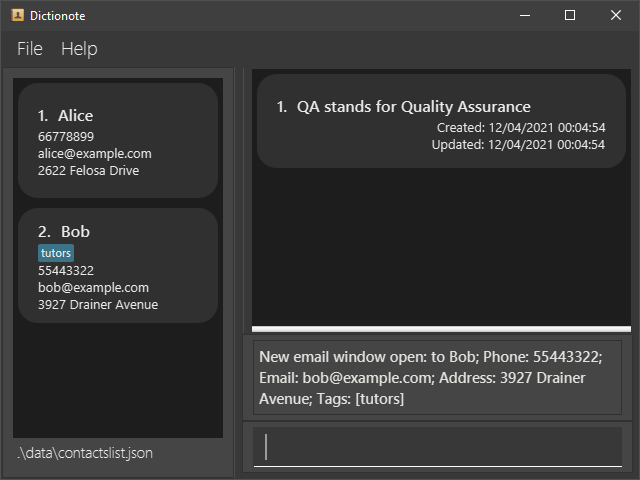
- A new window, belonging to Microsoft Outlook’s
New Messagefunction, will pop up:

- Note that the email of the selected contact, Bob (referred to in the command by his index number), is automatically written in the
To...field of the email’s header information. - Also note that the body of the message contains the contents of the first note on the list (that is,
QA stands for Quality Assurance).
In case the user does not have a mail client software set as default in their OS, Dictionote will try to navigate to the mailto link through the user’s default browser (i.e., the mailto link will be treated as an ordinary URL link).
Design Considerations
-
Alternative 1 (current choice): make use of the OS mail client to facilitate email features.
- Pros: Easy to implement; utilizes a pre-existing and standardized system for invoking mail clients.
- Cons: Requires the user to have a mail client installed on their OS, which is then set to be the default mail client of the system.
-
Alternative 2: implement basic email features directly into Dictionote.
- Pros: Does not depened on the existence of external software in the OS.
- Cons: Much harder to implement, as it requires the implementation of network-related functions to handle the connections to email servers.
Sorting the contacts list by most-frequently contacted
Implementation
This feature is implemented as a command, MostFreqContact, that extends Command. It can execute without arguments, and it ignores any of them if provided.
The execute() method attempts to sort all contacts stored within the contacts list in descending order based on each contact’s frequency counter, which is an attribute holding a non-negative integer value that represents the number of attempts an email was sent to that contact. The sorting is handled by the sorted method of the ObservableList class, of which an instance stores the contacts.
As an example, consider running Dictionote as follows:
- Assume that the current state of the application is as follows (note the exisiting contacts on the left-side of the application’s window):
- In addition, assume the successful execution of the following commands:
-
emailcontact 3three times. -
emailcontact 2one time. -
emailcontact 1two times.
-
- After typing in
mostfreqcontactand executing it, the result would be:
- Note that the ordering of the contacts in the contacts list had changed, with Charlie (formerly with index number 3) being the first on the list, followed by Alice (formerly with index number 1) and finally Bob (formerly with index number 2).
Design Considerations
-
Alternative 1 (current choice): add a new attribute to the
Contactclass in order to keep track of the number of attempts to send an email.- Pros: Preserves the functionality of the
Contactclass before the implementation of the new feature; minimal integration issues with otherContact-dependent classes and methods. - Cons: Requires the creation of a new class to represent this attribute; adds an extra attribute to the contacts list’s JSON storage file, which might requires more space (although it may be minimal).
- Pros: Preserves the functionality of the
-
Alternative 2: create a
HashTableto store a mapping between the contacts and the number of attempts to send an email of which they were the recipients.- Pros: Zero modifications on the
Contactclass;Contactobjects will not contain any attributes required by this feature. - Cons: Difficult to integrate with the other classes and methods related to
Contactobjects (e.g., deletion of a contact from the list must propagate to theHashTable).
- Pros: Zero modifications on the
UI features
Opening and closing UI through command result
Implementation
Dictionote has an interactive user interface that allows the user to open and close any panel through command.
Furthermore, when any command is executed,
Dictionote should be able to change the user interface based on the command type/requirement.
All commands should be able to open and close its required UI panel.
The user will also be able to open and close the UI via user command.
The feature is implemented using CommandResult, which is returned by all Command in the system.
CommandResult contain a String object call feedbackToUser, a UiAction enum call uiAction
and UiActionOption enum call uiActionOption. feedbackToUser will
be show on the ResultDisplay indicating the command feedback after execution.
uiAction indicate the action the command want the UI to take.
e.g UiAction.OPEN, UiAction.CLOSE, … etc. UiActionOption is only applicable to some UiAction.
It indicate the specific option available for the UiAction.
e.g UiActionOption.CONTACT for UiAction.OPEN mean open contact panel.
The following is the sequence diagram for executing a command to open a panel.
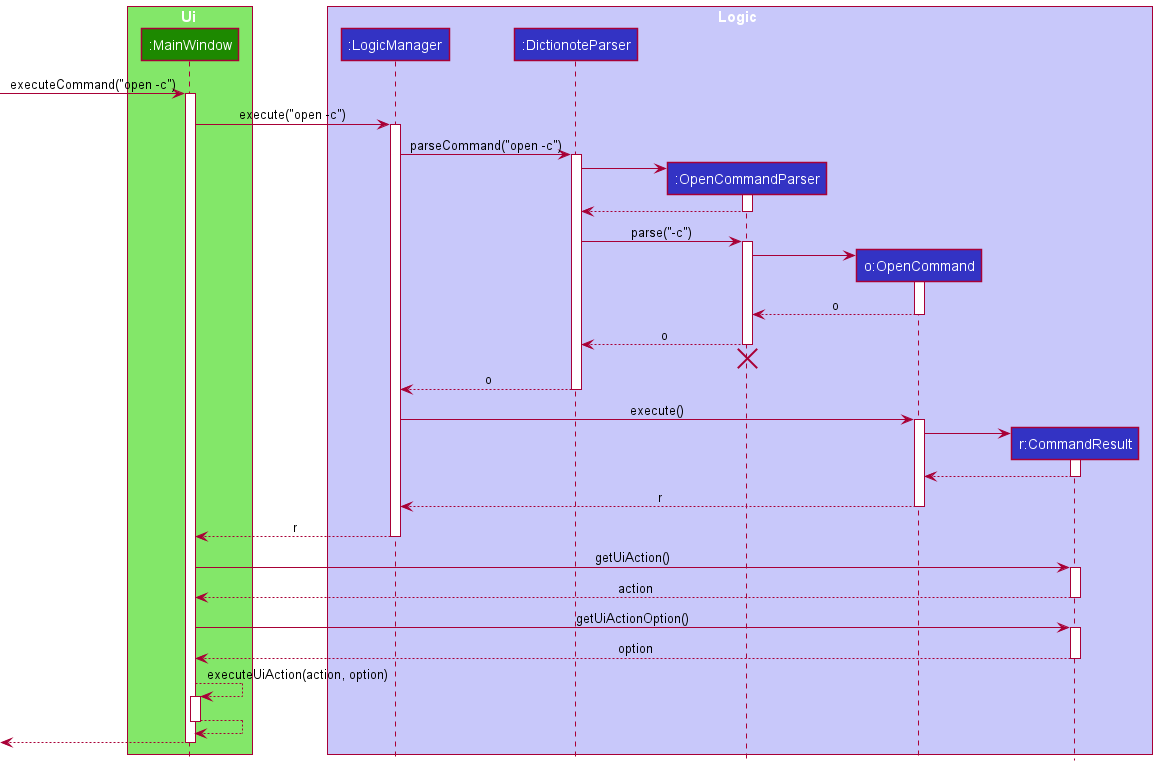
Design Consideration
-
Alternative 1 (current choice): Make use of the existing
CommandResultclass- Pros: Make use of the existing system and easy to implement
- Cons: All command will have to decide on the response. (or use the default setting) (desire behaviour)
- Alternative 2: Make use of the
Modelcomponent as an intermediary between Command and UI. The command will call a method available on theModelcomponent to change the UI settings, theUIwill listen to the setting on theModelcomponent.- Pros: Only the class that requires to change the UI will be needed to call the method.
- Cons: Increasing coupling.
Command that manipulation UI settings
Implementation
While all Command has the ability to open and close the UI. There are some UI settings that are more specific.
In this case, we don’t want all commands to implement its behavior, so using CommandResult isn’t ideal.
Since the UI component is already uses GuiSettings to store its settings when Dictionote close.
We can make use of the existing structure by making the UI component
to actively listen for changes to the GuiSettings.
The features are implemented in all toggledivider and setdividerposition commands.
The command will change the GuiSettings located in Model componenet.
When the CommandResult is returned to the UI component.
The UI component will check for changes in GuiSettings and update it Ui according.
The following is the sequence diagram for executing a command to set note divider position.

In the sequence diagram, executeUiAction(action,option) is called.
This is to show that the command ensure that the user receives proper feedback when the divider position changes.
The command will open all panels that were affected by the divider position change.
If the affected panel remain closed, the user will not be able to notice the changes.
Note divider affect both NoteListPanel and NoteContentPanel, hence if its is closed, they will be open.
The execution of the command will make both NoteListPanel and NoteContentPanel visible,
and the note divider positions will be adjusted to the desired position
Design Consideration
- Alternative 1 Make use of the existing
CommandResultclass- Pros: Make use of the existing system and easy to implement
- Cons: All command will have to decide on the response. (or use the default setting)
-
Alternative 2(current choice):: Make use of the
Modelcomponent as an intermediary between Command and UI. The command will call a method available on theModelcomponent to change the UI settings, theUIwill listen to the setting on theModelcomponent.- Pros: Only the class that requires to change the UI will be needed to call the method.
- Cons: Increasing coupling.
Note Features
Converting a note into a .txt file
Dictionote provides a method for its users to convert a note into a text file that are easily editable in other softwares.
This feature is implemented as a command, ConvertTxtNoteCommand, that extends Command. It is an index-dependent command, meaning that the user must provide an index number when typing the command as a reference to a specific note on the note list.
The execute() method will calls a ConvertTxtNote function, which uses Java’s BufferedWriter and FileWriter class to write remotely.
Here is the example of the command usage. Assume initially, the state of the application is shown below:
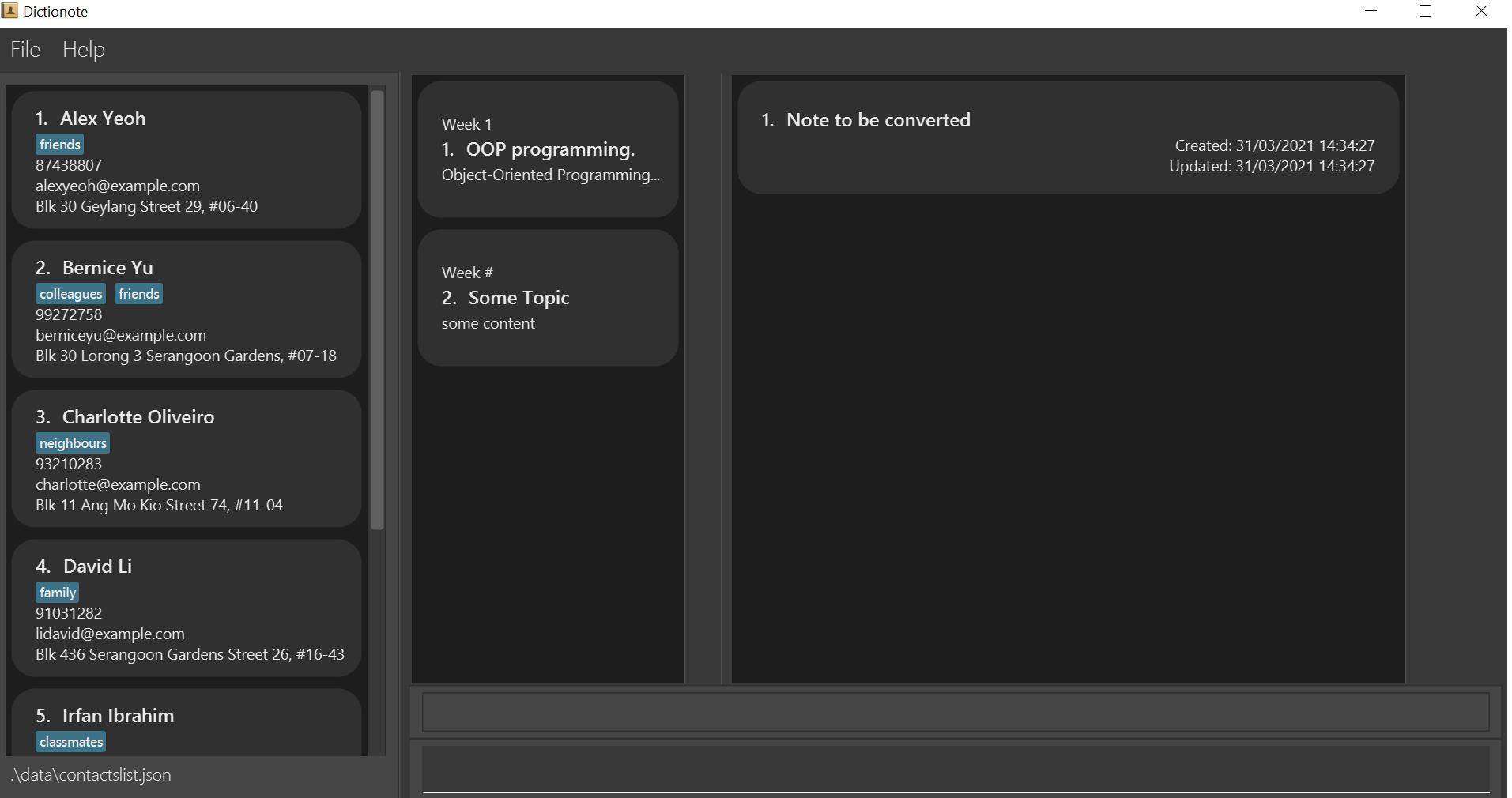
- After typing in
converttxt 1and executing it, the result would be:
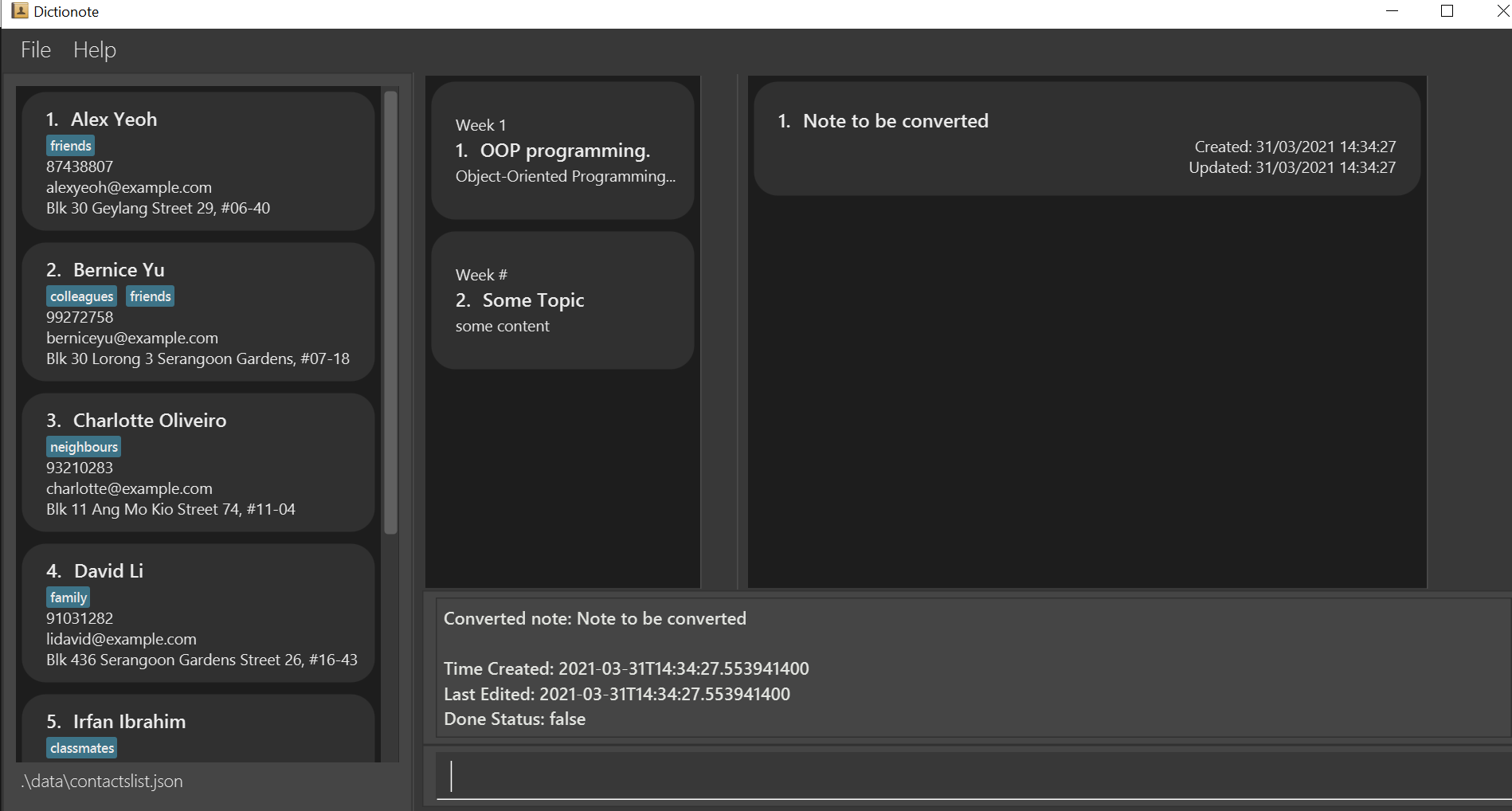
- The resulting text file can be seen in the
datafolder.
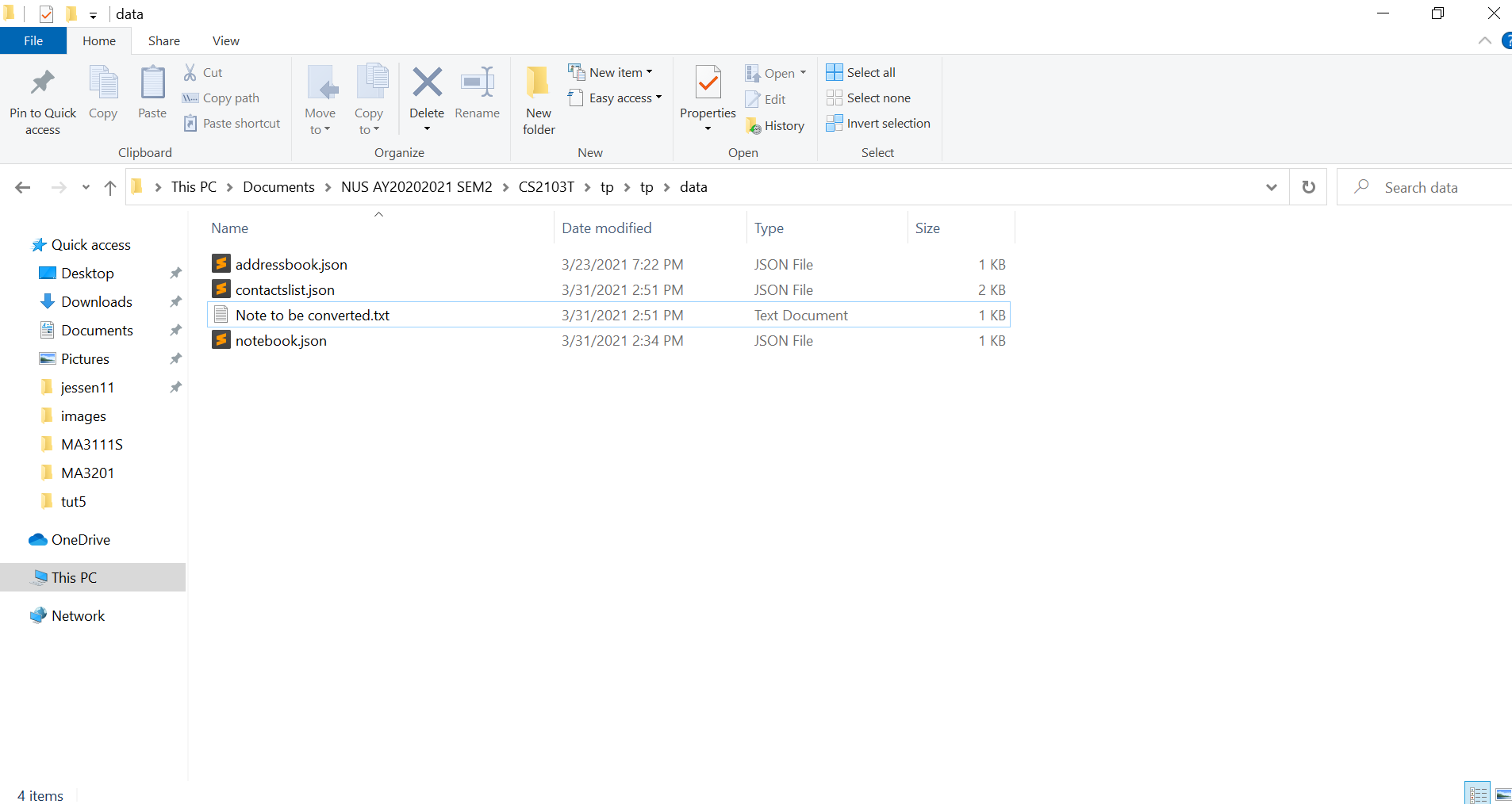
- Here is the resulting note.
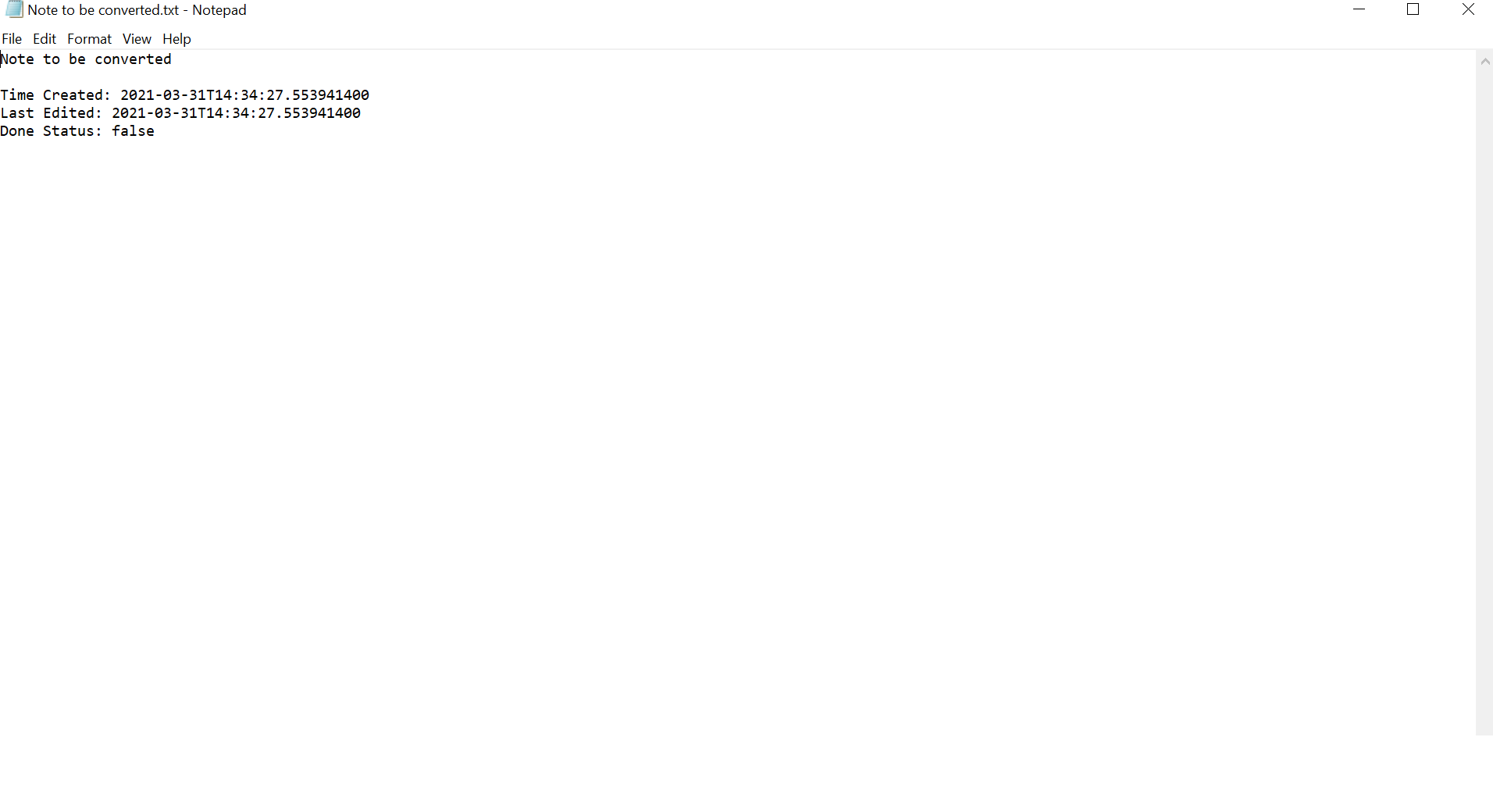
Design Consideration
-
Alternative 1 (current choice): make use of the Java’s
FileWriterclass to help us write files.- Pros: Easy to implement; utilizes a pre-existing and standardized system for file writing.
- Cons: Need to modify code later for enhancement later.
-
Alternative 2: make our customized note-to-text converter class.
- Pros: Enable us to convert more than text files and have specific usage for our code.
- Cons: Very hard to implement, not enough time and knowledge.
Merge two notes into one
Dictionote provides a method for its users to merge two notes into one combined note.
This feature is implemented as a command, MergeNoteCommand, that extends Command. It is an index-dependent command, meaning that the user must provide 2 indexes number when typing the command as a reference to the notes that would like to be merged.
The execute() method will calls a mergeNote function which would delete both notes from NoteBook and add a new combined note into the NoteBook.
Here is the example of the command usage. Assume initially, the state of the application is shown below:
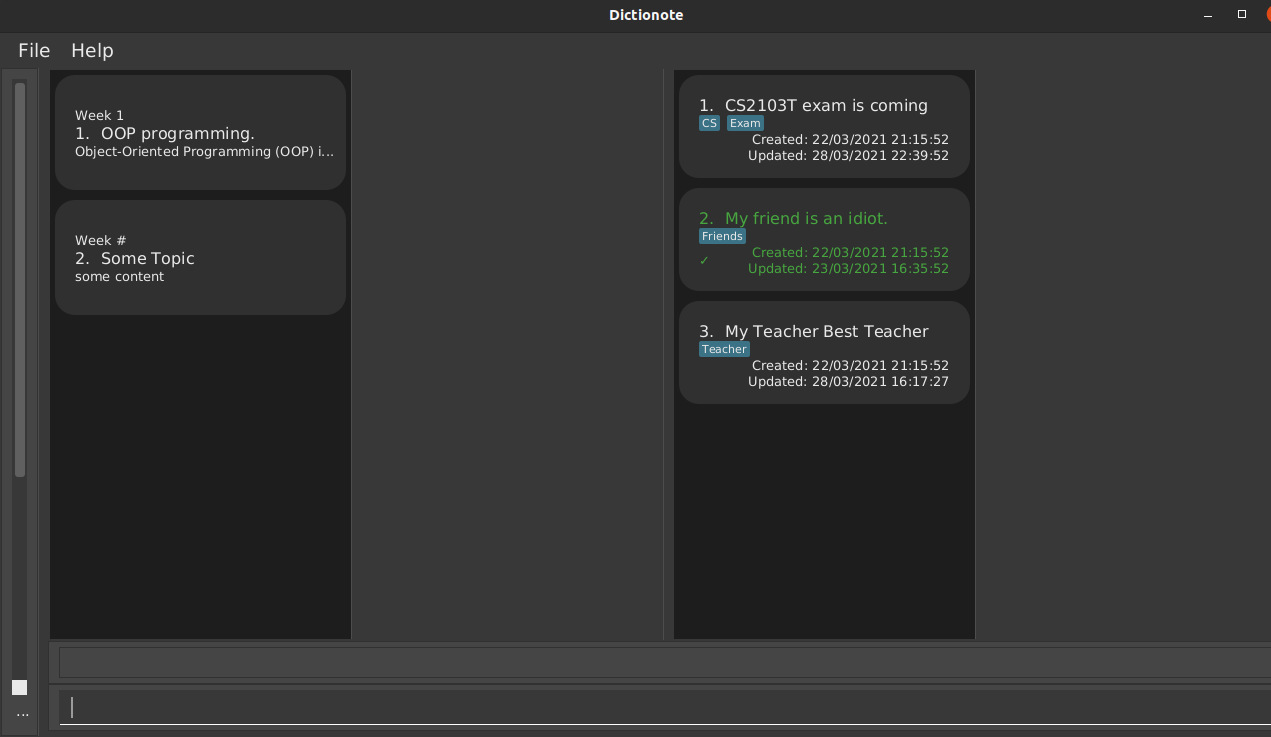
After typing in mergenote 1 2 and executing it, the result would be:
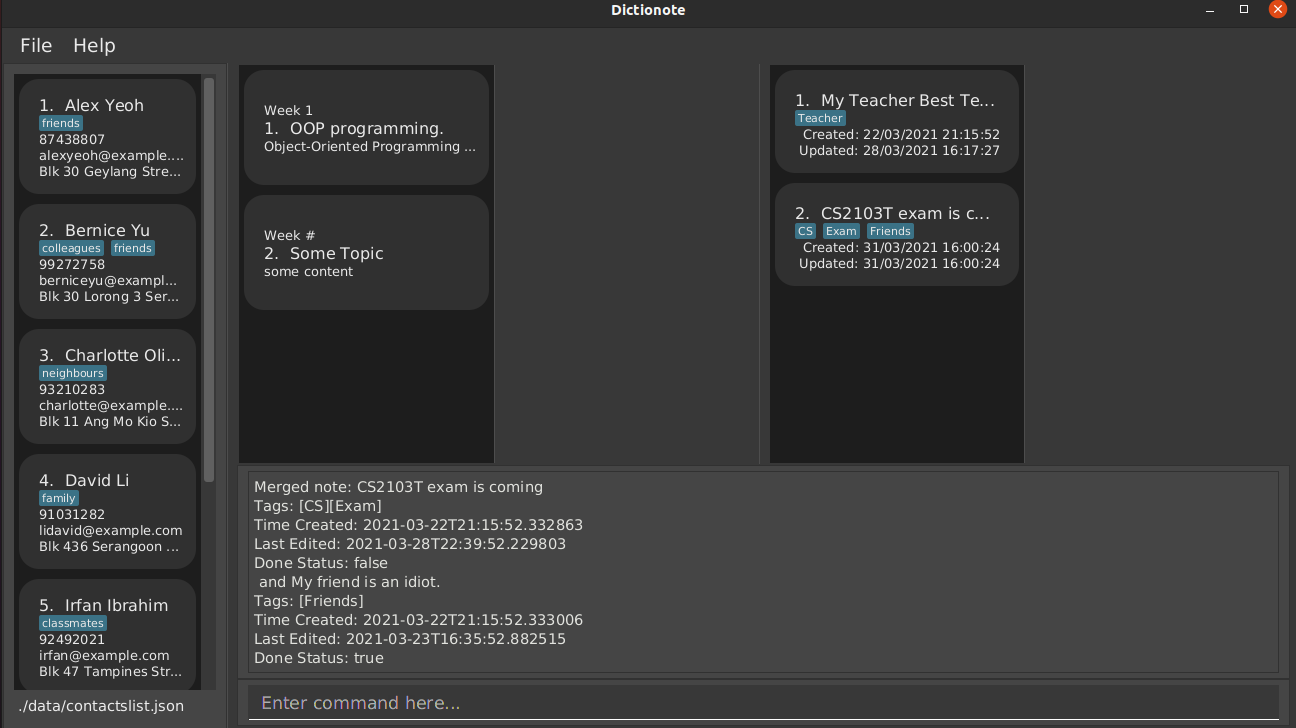
Design Consideration
-
Alternative 1 (current choice): Implement MergeNoteCommand which extends Command.
- Pros: Easy to implement; match the design pattern already inherited from AB3.
- Cons: More lines of code.
-
Alternative 2: Make MergeNoteCommand as a function from the model immediately.
- Pros: Less Lines of Code and simpler due to not extending the Command class.
- Cons: Might be confusing as some of the commands are already implented and might not be consistent with other commands.
Dictionary features
Copying Content to a Note
Implementation
Dictionote provides a way for users to copy over the content from the dictionary to a note.
This feature is implemented as a command, copytonote, combining 2 models, namely the ‘Content’, and the ‘Note’ Models.
The execute() method will first call on getFilteredCurrentDictionaryList() to get the currently shown list in the dictionary panel.
The method will then get the index keyed in by the user and find the corresponding content from the list at the index.
A String object will then be created to store this information by getting the content body of the Content using the get() method.
The nextstep is to produce a new note by calling the new Note() constructor, with the note content being the String object created by the get() method.
Finally, the method will call on addNote() to add the created note into the notes list.
The execute() method will facilitate the display of the new note in the note list panel.
The following is the sequence diagram for executing the execute() command in copying a content to a note.

Design Consideration
-
Alternative 1 (current choice): Make use of the existing
NoteandContentmodels.- Pros: Make use of the existing system and easy to implement
- Cons: Different methods and constructors have to be called since there exists 2 different models, which can induce type casting conflicts or get confusing.
- Alternative 2: Create a new model that will contain a mix of the
NoteandContentmodels.- Pros: No constructors have to called and there won’t be a need to worry about type casting failures.
- Cons: Increasing workload and no other features will use this new model.
Documentation, logging, testing, configuration, dev-ops
Appendix: Requirements
Product scope
Target user profile:
- Tech-Savvy CS2103T Student
- want to ask questions
- need to find answers
- prefers to take notes
Value proposition:
- Main problem: no organized platform to facilitate extra learning outside of class.
- Sub-Problems
- Easy and quick way for students to get answers for CS2103T questions.
- Easy for students to take notes.
- Easy way for students to find their classmates.
- Limitations:
- Unable to provide students with thorough materials/all the answers.
- Unable to play videos from lectures.
User stories
| Priority | As a … | I want to … | So that I can… | Category |
|---|---|---|---|---|
| UI | ||||
* * |
CS2103 Student | View note and dictionary side-by-side | Easily copy dictionary content to note | Essential |
* * |
CS2103 Student | Open and close Contact panel | Have more space for other content | Non-essential |
* * |
CS2103 Student | Open and close Dictionary Content panel | Have more space for other content | Non-essential |
* * |
CS2103 Student | Open and close Dictionary List panel | Have more space for other content | Non-essential |
* * |
CS2103 Student | Open and close Note Content panel | Have more space for other content | Non-essential |
* * |
CS2103 Student | Open and close Note List panel | Have more space for other content | Non-essential |
* * |
CS2103 Student | Save my UI configuration | Save my time on re-adjusting the Ui everytime I open the app | Non-essential |
* * |
CS2103 Student | Change my UI configuration | Do no need to adjust the UI using mouse | Non-essential |
* * |
CS2103 Student | Change my UI orientation | Use the space available more efficiently | Non-essential |
| Dictionary | ||||
* * * |
CS2103T student who find it troublesome to use the website | Search for a definition of an SE term | Understand what it means | Essential |
* * * |
CS2103T student | Find content I need | Save time having to dig through the textbook | Essential |
* * * |
CS2103T student | List all the contents in the dictionary | View the extensive list of contents | Essential |
* * * |
CS2103T student | List all the definitions in the dictionary | View the extensive list of contents | Essential |
* |
CS2103T student | Track my progress when reading through a summary | Continue my preparation from where I left off | Non-essential |
* * |
CS2103T student | Copy specific contents in the dictionary to the notes | Keep track of the important content on my personal note list | Non-essential |
| Note | ||||
* * * |
CS2103T student | Take a new note | Have easy access to my materials whenever I need them | Essential |
* * * |
CS2103T student | Delete an existing note | Remove out-of-date notes. | Essential |
* * * |
CS2103T student | Edit a note | Revise a small typo in the note. | Essential |
* * * |
CS2103T student | Look at all notes | Remember what is the content of the note | Essential |
* * * |
CS2103T student | Show a specific note | To read the content of a specific note in detail | Essential |
* * * |
CS2103T student | Edit a note in edit mode | Modify the content of the note easily. | Essential |
* * |
CS2103T student | Tag a note | I can access notes easily. | Non-Essential |
* * |
CS2103T student | Track the date and time the note is created | Find the note according to the time created | Non-Essential |
* * |
CS2103T student | Sort a note alphabetically | I can read the notes in order. | Non-Essential |
* * |
CS2103T student | Search a note using keyword | Find out what notes contain the specific keyword. | Non-Essential |
* * |
CS2103T student | Mark a note as undone | Remember which part of the notes I have not done yet. | Non-Essential |
* * |
CS2103T student | Mark all notes as undone | Reset all the features I have marked as done. | Non-Essential |
* |
CS2103T student | Track the date and time the note is last modified | Find the note according to the time last modify. | Non-Essential |
* |
CS2103T student | Mark a content of a note as done | Remember which part of the notes I have done. | Non-Essential |
| Contact | ||||
* * * |
CS2103T Student | Add my contacts | Easily manage the contacts list | Essential |
* * * |
CS2103T Student | Edit my contacts | Easily manage the contacts list | Essential |
* * * |
CS2103T Student | Delete my contacts | Easily manage the contacts list | Essential |
* * * |
CS2103T Student | Look at all contacts | Easily manage the contacts list | Essential |
* * |
CS2103T Student | Tag a contact with a word | Find contacts based on their tags | Non-essential |
* * |
CS2103T Student | Search for contacts using tags | Contact anyone from a particular tag | Non-essential |
* * |
CS2103T Student who wants to connect with others that I know | Email anyone from my contacts list | Ask questions, discuss topics, or exchange notes with them | Non-essential |
* * |
Extroverted student who likes to discuss things with friends | Locate the contacts whom I frequently contact | Save time having to look for them in my address book | Non-essential |
* * |
CS2103T student | Send a note by email | Easily discuss the contents of a particular note with one of my contacts | Non-essential |
* * |
CS2103T Student | Search the email of my friends | I can easily find for whom a particular email address is. | Non-essential |
| Guide | ||||
* * * |
CS2103T student who is bad at remembering commands | Access the list of commands with brief explanation | Save time having to search through user guide for details | Essential |
* * * |
CS2103T student who uses commands often | Scan through the list of commands for a quick refresher | Save time having to search through user guide for all command | Essential |
Use cases
(For all use cases below, the System is the Dictionote and the Actor is the user, unless specified otherwise)
Use case: UC01 - Close a panel
MSS
- User requests to close a specific display panel.
-
Dictionote close the display Panel.
Use case ends.
Extensions
- 1a. The given display panel is invalid.
-
1a1. Dictionote shows an error message.
Use case ends.
-
Use case: UC02 - Edit and save a note in edit mode
MSS
- User requests to edit in edit mode.
- Dictionote enable edit mode.
- User edit note and request to save the note.
- Dictionote save edited note.
-
Dictionote exit edit mode.
Use case ends.
Extensions
- 1a. No note is shown in note content panel.
-
1a1. Dictionote shows an error message.
Use case ends.
-
- 3a. Dictionote found the note the user trying to save were a duplicate of another note in the system.
- 3a1. Dictionote shows an error message.
-
3a2. User edit note with new content and request to save the note.
Steps 3a1-3a2 are repeated until the note the User is trying to save is not a duplicate.
Use case resumes from step 4.
- * a. At any time, User chooses to exit edit mode.
- *a1. Dictionote discard edited note.
-
*a2. Dictionote exit edit mode.
Use case ends.
Use case: UC03 - Delete a contact
MSS
- User requests to list contacts.
- Dictionote shows a list of contacts.
- User requests to delete a specific contact in the list.
-
Dictionote deletes the contact.
Use case ends.
Extensions
-
2a. The list is empty.
Use case ends.
-
3a. The given index is invalid.
-
3a1. Dictionote shows an error message.
Use case resumes at step 2.
-
Use case: UC04 - Clear the contacts list
MSS
- User requests to clear their contacts list.
-
Dictionote clears the contacts list by deleting all contacts.
Use case ends.
Extensions
-
1a. The list is empty.
Use case ends.
Use case: UC05 - Send an email to a contact
Actors: User, Operating System (OS), Mail Application, Web Browser.
MSS
- User requests to list contacts.
- Dictionote shows a list of contacts.
- User requests to send an email to the contact located at the specified index number.
- Dictionote invokes the OS’s mail application with the appropriate fields filled in.
- User types in a subject for the message.
- User sends the message through the mail application.
Use case ends.
Extensions
-
2a. The list is empty.
Use case ends.
-
3a. User provides a note index whose contents are requested to be sent.
Use case resumes from step 4.
-
4a. OS does not have a default mail application set.
- 4a1. OS invokes its default web browser.
- 4a2. Web browser opens a new, empty tab.
Use case ends.
Use case: UC06 - Delete a note
MSS
- User requests to list notes.
- Dictionote shows a list of notes.
- User requests to delete a specific note in the list.
-
Dictionote deletes the note.
Use case ends.
Extensions
-
2a. The list is empty.
Use case ends.
-
3a. The given index is invalid.
-
3a1. Dictionote shows an error message.
Use case resumes at step 2.
-
Use case: UC07 - Sort notes by Last Edit Time
MSS
- User requests to list notes.
- Dictionote shows a list of notes.
- User requests to sort notes based on the last edit time.
-
Dictionote shows a list of notes, sorted by last edit time.
Use case ends.
Extensions
-
2a. The list is empty.
Use case ends.
Use case: UC08 - Find Content in the Dictionary
MSS
- User requests to list content.
- Dictionote shows a list of content.
- User requests to find content using a certain set of keywords.
-
Dictionote shows the list of contents matching those keywords.
Use case ends.
Extensions
-
1a. The list is empty.
Use case ends.
Use case: UC09 - Copy Content to Note
MSS
- User requests to list content.
- Dictionote shows a list of content.
- User requests to show the content at a specific index.
- Dictionote shows the content.
- User requests to content the content at a specific index to a note.
- Dictionte adds a new note with the note body being the content at that index.
Extensions
-
1a. The list is empty.
Use case ends.
-
3a. The given index is invalid.
-
3a1. Dictionote shows an error message.
Use case resumes at step 2.
-
-
5a. The given index is invalid.
-
5a1. Dictionote shows an error message.
Use case resumes at step 4.
-
Use case: UC10 - List all notes
MSS
- User requests to list notes.
-
Dictionote shows a list of notes which might or might not be empty.
Use case ends.
Use case: UC11 - Show a specific note
MSS
- User requests to show a specific note.
-
Dictionote shows note requested by the user in the rightmost panel.
Use case ends.
Extensions
-
1a. The requested index is out of bounds. Then an index invalid exception will arise.
Use case ends.
Non-Functional Requirements
User Requirement
- Typing Preferred User
- user should be targeting user who can type fast
- user should have above average typing speed for regular English text
Software Requirement
- Single User
- should be for single user.
- Human Editable File
- data should be stored locally and should be in a human editable text file.
- Single File
- should work with a single JAR file
- File Size
- file sizes of the deliverables should not exceed the
100MB
- file sizes of the deliverables should not exceed the
Dependency Requirement
- Platform Independent
- should work on Windows, Linux and OS-X platform.
- avoid using OS-dependent libraries and OS-specific features
- Java version
- Should work on any mainstream OS as long as it has Java
11or above installed. - should work without requiring an installer
- Should work on any mainstream OS as long as it has Java
- Portable
- should work without requiring an installer
- External Software
- Third party frameworks/libraries is subjected to approval, and only if they,
- are free, open-source, and have permissive license.
- do not require any installation by the user of your software.
- do not violate other constraint.
- Third party frameworks/libraries is subjected to approval, and only if they,
- No Database Management System
- should not use any database management system to store data.
Documentation Requirement
- PDF Friendly
- The Developer Guide and User Guide should be PDF-friendly.
- do not use expandable panels, embedded videos, animated GIFs etc.
- File Size
- file sizes of documents should not exceed the
15MB
- file sizes of documents should not exceed the
Glossary
- Mainstream OS: Windows, Linux, Unix, OS-X
Appendix: Instructions for manual testing
Given below are instructions to test the app manually. Note that some tests use specific data in their examples, which might need to be inserted first using CRUD commands; however, it is possible to replace such specific data with already-existing ones found by default in the application.
Launch and shutdown
-
Initial launch
-
Download the jar file and copy into an empty folder
-
Double-click the jar file Expected: Shows the GUI with a set of sample contacts. The window size may not be optimum.
-
-
Saving window preferences
-
Resize the window to an optimum size. Move the window to a different location. Close the window.
-
Re-launch the app by double-clicking the jar file.
Expected: The most recent window size and location is retained.
-
Adding and editing a contact
-
Adding a contact that shares its phone number with another existing contact.
-
Prerequisites: At least one contact is present in the list.
-
Assumptions: One contact is present with the phone number
11223344. -
Test case:
addcontact p/11223344 n/<ANY_NAME> a/<ANY_ADDRESS> e/<ANY_UNIQUE_EMAIL>
Expected: An error message is displayed, telling that another existing contact already has the specified phone number or email.
- Note that this behavior should apply for any phone number that is already used for another contact in the list.
-
-
Adding a contact that shares its email with another existing contact.
-
Prerequisites: At least one contact is present in the list.
-
Assumptions: One contact is present with the email
taken@email.com. -
Test case:
addcontact e/taken@email.com n/<ANY_NAME> a/<ANY_ADDRESS> p/<ANY_UNIQUE_PHONE_NUMBER>
Expected: An error message is displayed, telling that another existing contact already has the specified phone number or email.
- Note that this behavior should apply for any email that is already used for another contact in the list.
-
-
Editing a contact is similar to Adding a contact above (shared phone numbers and/or emails).
Deleting a note
-
Deleting a note while all notes are being shown
-
Prerequisites: List all notes using the
listnotecommand. Multiple notes in the list. -
Test case:
deletenote 1
Expected: First note is deleted from the list. Details of the deleted note shown in the status message. Timestamp in the status bar is updated. -
Test case:
deletenote 0
Expected: No note is deleted. Error details shown in the status message. Status bar remains the same. -
Other incorrect delete commands to try:
deletenote,deletenote x,...(wherexis larger than the list size)
Expected: Similar to previous.
-
Showing a note
-
Showing a specific note
-
Prerequisites: List all notes using the
listnotecommand. Multiple notes in the list. -
Test case:
shownote 1
Expected: First note is shown on the rightmost panel. Details of the showed note is shown there. -
Test case:
shownote 0
Expected: No note is showed. Error details shown in the status message. Status bar remains the same. -
Other incorrect delete commands to try:
shownote,shownote x,...(wherexis larger than the list size)
Expected: Similar to previous.
-
Finding Content
-
Finding a specific Content in the Dictionary.
-
Prerequisites: List all contents using the
listcontentcommand. Multiple contents in the list. -
Test case:
findcontent hello
Expected: No content is shown. The panel should be empty. -
Test case:
findcontent implement
Expected: 4 contents should be shown in the Dictionary list panel. -
Other incorrect delete commands to try:
findcontent,findcontent,...(where ` ` is a space)
Expected: Error message should be shown, stating that there is an ‘invalid command format’.
Showing content/definition
-
Showing a specific content/definition
-
Prerequisites: Have some contents available in the Dictionary List Panel, commands to facilitate that will be
listcontent,findcontent programming,listdef, etc. -
Test case:
showdc 1
Expected: First content in the Dictionary List Panel is shown on the Dictionary Content Panel. Details of the showed content is shown there. -
Test case:
showdc 0
Expected: No content is showed. Error details shown in the status message. Status bar remains the same. -
Other incorrect delete commands to try:
showdc,showdc x,...(wherexis larger than the list size)
Expected: Similar to previous.
Modifying the UI through command
For more information regarding the panel layout and divider position, please refer to the user guide - UI section for more details.
Opening and closing display panel
Available OPTION for open and close command : -a, -c, -d, dc, dl, -n, -nc, nl, -l
-
Opening a panel through open command
-
Prerequisites: Close all panel using
close -afor better visibility -
Test Case :
open -c
Expected : Contact panel will be open -
Test Case :
open -c
Expected : Contact will remain open -
Repeat the previous steps for all
OPTION
(check user guide for more detail about the option.) -
Test Case :
open -x
Expected : Invalid command messages will be shown -
Other incorrect open commands to try:
open,open x,...(where x is not anOption)
Expected: Similar to previous.
-
-
Close a panel through open command
-
Prerequisites: Close all panel using
open -afor better visibility -
Test Case :
close -c
Expected : Contact panel will be close -
Test Case :
close -c
Expected : Contact will remain close -
Repeat the previous steps for all
OPTION
(check user guide for more detail about the option.) -
Test Case :
close -x
Expected : Invalid command messages will be shown -
Other incorrect open commands to try:
close,close x,...(where x is not anOption)
Expected: Similar to previous.
-
Setting divider position via command
List of availble set divider position command : setdividerc, setdividerd, setdividern, setdividerm
Range of valid POSITION for set divider command : 1 to 9 (Inclusively)
-
Setting position of a panel through open command
-
Prerequisites: Close all panel using
close -cfor better visibility -
Test Case :
setdividerc 5
Expected : contact divider will be set at the halfway mark. contact panel should be open.
(check user guide for more detail for where each position represent.) -
Test Case :
setdividerc 5
Expected : Contact will remain open -
Test Case :
setdividerc 0
Expected : Invalid command messages will be shown -
Other incorrect open commands to try:
setdividerc,setdividerc x,...(where x is not within the valid range)
Expected: Similar to previous.
-
-
Repeat the previous test case with
setdivider,setdividerd, andsetdividerm.
Toggling divider orientation via command
List of availble toggle divider orientation command : toggledividerd, toggledividern
-
Setting position of a panel through open command
-
Test Case :
toggledividerd
Expected : Dictionary divider orientation will change to horizontal if it vertical, vice-verse. if note list panel or note content panel is closed, it will be open. -
Test Case :
toggledividerd
Expected : Dictionary divider orientation will change to horizontal if it vertical, vice-verse. -
Test Case :
toggledividerd
Expected : Dictionary divider orientation will change to horizontal if it vertical, vice-verse.
-
-
Repeat the previous test case with
toggledividern.
Saving data
-
Dealing with missing/corrupted data files
- If the data files are corrupted. The data will be wiped clean and an empty data file will be generated.
